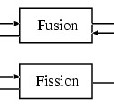Earlier Highlights (4)
 In September 2003, Jun Makino and I opened a web site, http://www.artcompsci.org, to make our new book series available, as it will grow. The series is titled The Art of Computational Science. In it, we plan to present a self-contained hands-on guide to building a software environment, using the gravitational many-body problem as a specific example.
In September 2003, Jun Makino and I opened a web site, http://www.artcompsci.org, to make our new book series available, as it will grow. The series is titled The Art of Computational Science. In it, we plan to present a self-contained hands-on guide to building a software environment, using the gravitational many-body problem as a specific example.
In July 2003, Rosemary Mardling and I organized the workshop MODEST-3, in Melbourne, Australia. This was the third in a series of workshops to discuss MOdeling DEnse STellar systems. I gave a review of what has been accomplished in these three meetings, at the General Assembly conference of the IAU in Sydney.
 <- In June 2003, Jun Makino and I started the design of our Kali code, a new N-body code for modeling dense stellar systems. Unlike any previous N-body code with which we have experience, we have started our design fully top-down, by first developing complete specifications for all interfaces between the various modules, allowing swapping of individual modules (in the sample figure we show the five modules within the local stellar dynamics module, which itself is one of the four main modules of the code).
<- In June 2003, Jun Makino and I started the design of our Kali code, a new N-body code for modeling dense stellar systems. Unlike any previous N-body code with which we have experience, we have started our design fully top-down, by first developing complete specifications for all interfaces between the various modules, allowing swapping of individual modules (in the sample figure we show the five modules within the local stellar dynamics module, which itself is one of the four main modules of the code).
In May 2003, a number of fun things happened: I started to receive email from space, from my friend Ed Lu, the only American astronaut currently based on the space station. Not only do I exchange email with him, but he sometimes calls me on my cell phone, if he has nothing better to do up there; it was quite a surprise, the first time! And I was quoted on two rather different subjects: in the New York Times (May 13, 2003, p. F3, Column 2) on the question of whether fish feel pain, and in the Wall Street Journal (May 30, 2003, p. B1, column 1) on the question of whether there may be wormholes to other universes.
 <- In March 2003, I organized a workshop on deflecting asteroids, together with Rusty Schweickart, retired Apollo astronaut, at the NASA Johnson Space Center in Houston, TX. The workshop was titled "Founder's Meeting II", since it was the follow-up meeting of a previous workshop that we held in Houston in 2001, that led to us founding the B612 Foundation.
<- In March 2003, I organized a workshop on deflecting asteroids, together with Rusty Schweickart, retired Apollo astronaut, at the NASA Johnson Space Center in Houston, TX. The workshop was titled "Founder's Meeting II", since it was the follow-up meeting of a previous workshop that we held in Houston in 2001, that led to us founding the B612 Foundation.
Also in March, I gave a talk titled Degrees of Freedom at the Center for the Study of Science & Religion at Columbia University.
In February 2003, I wrote a commentary on ways to revamp NASA's human exploration of space, by visiting asteroids. It appeared on the edge web site obsequy for the astronauts of space shuttle Columbia.
 <- Also in February, our book The Gravitational Million-Body Problem appeared in the U.S. My co-author Douglas Heggie saw the publication a month earlier in the U.K.
<- Also in February, our book The Gravitational Million-Body Problem appeared in the U.S. My co-author Douglas Heggie saw the publication a month earlier in the U.K.
In January 2003, an OpEd piece in the New York Times quoted my New Year's contribution to the The World Question Center, in which I mentioned the need to develop proven technology to deflect asteroids. See the NYT page or John Brockman's edge page, and the commentary on space.com
Also in January, NASA offered a press release to announce the publication of our simulations of the globular cluster M15, where we put limits on the mass of a central black hole. See also the comments in Science Daily and space.com.